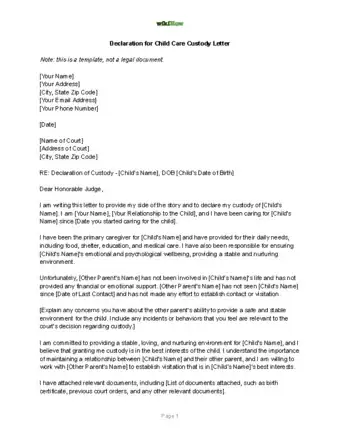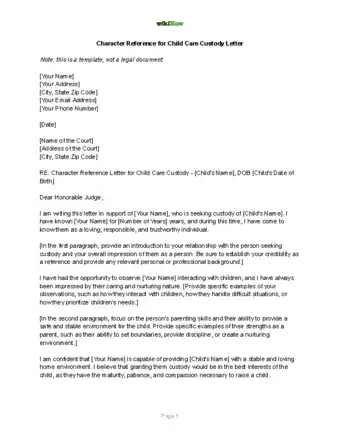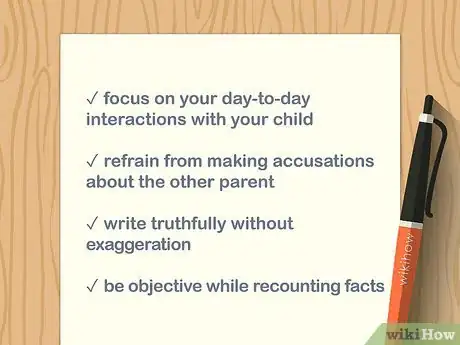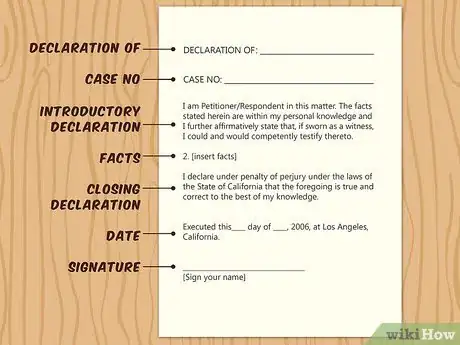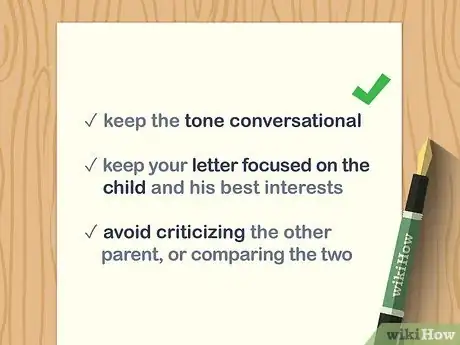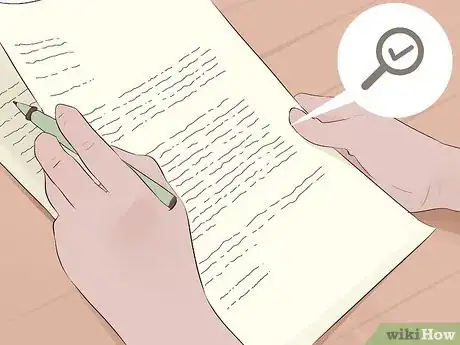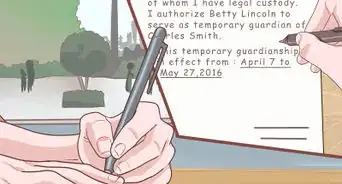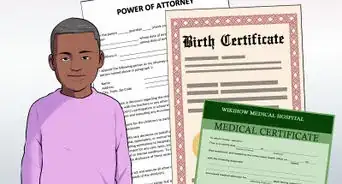This article was written by Jennifer Mueller, JD. Jennifer Mueller is an in-house legal expert at wikiHow. Jennifer reviews, fact-checks, and evaluates wikiHow's legal content to ensure thoroughness and accuracy. She received her JD from Indiana University Maurer School of Law in 2006.
This article has been viewed 113,987 times.
If you are filing for child custody, the judge may ask you to write a letter of declaration that explains your side of the story – for example, if the other parent contests your custody, or if a representative for your child such as a guardian ad litem has filed a report with the court recommending a different custody arrangement than the one you requested. If someone close to you is in the midst of child custody proceedings, he or she also might ask you to write a character reference letter to submit to the court. These letters have a few formal requirements, but generally can be drafted without the assistance of an attorney.
Steps
Letter for Child Custody Templates
Writing a Letter of Declaration
-
1Study any other documents or reports filed. If issues have been raised in other documents filed with the court, read them so you have an understanding of the points you need to raise in your letter.
- For example, if the other parent alleges that the child is afraid of you, or upset at the thought of being with you, you would want to present to the court situations in which the child was happy and relaxed in your company.
- In addition to documents filed, review the factors the courts in your state consider when determining the best interests of the child.[1] You may be able to use those factors as a rough outline of the points you need to mention in your letter.
-
2Outline your letter. Making a basic outline of your letter before you start writing will help you stay on topic as you write and also give you an idea what documents or other evidence you might need to back up any statements you make.[2]
- Stick to the facts when you're explaining your side of the story. Although you do want to counter points made up in other reports filed, or issues raised by the other parent, you also want to make sure you don't get emotional or ramble. Instead, provide concrete examples that counter or tend to disprove the accusation.
- For example, if the other parent alleges that you don't pick up your child from school on time, you might note that you don't get off work until 5:30, but you made arrangements for the child to participate in an after-school program until you could pick her up from school.
Advertisement -
3Gather information or supporting documentation. If you have documents that support your statements, such as check stubs to back up the wages you claim to earn, those should be included with your letter.
- Your declaration gives you an opportunity to present evidence to the court, even if you anticipate testifying in court. This documentary evidence can serve to introduce the case to the judge or any appointed mediators.[3]
-
4Draft your letter. Follow your outline to draft the body of your letter explaining your position to the court.
- Focus on your day-to-day interactions with your child, and why the parenting plan you've proposed is in your child's best interests.[4]
- Keep in mind that the court will evaluate your case according to the child's best interests, not necessarily whether you or the child's other parent is a better person. For this reason you should refrain from making accusations about the other parent, especially as it regards your relationship with him rather than your relationship with your child.[5] [6]
- Start by introducing yourself and describing briefly the custody option you believe is best. The body of your letter will provide some reasons to back up your belief.
- If there are any urgent issues that hold key importance, address them first, then follow up with any other facts or circumstances.[7]
- Write truthfully without speculation or exaggeration. If you don't remember something exactly, indicate that by using words such as "approximately" or "typically."[8]
- Make sure anything you describe is something you personally saw, not something someone else told you.[9]
- Try to be as objective as possible when you recount facts.[10] As emotional as you may be, you should avoid disparaging or insulting the other parent.
-
5Format your letter. Check with your court to find out any necessary formatting that is required for your letter.
- For example, some courts require that you place the case's caption at the top of your letter. The caption is the heading at the top of all your court documents that gives the name of the court, the title of the case, and the case number.[11]
- Your state also may require particular language for the end of your letter, or have formatted signature blocks or notary blocks available for you to copy and use.[12]
-
6Proofread your letter. After you've got a final draft, read through it several times and correct any errors.
- You may consider having a trusted friend or an attorney review your letter to make sure you've not missed any bad typographical or grammatical errors.[13]
-
7Sign your letter. Many courts require you to sign your letter in the presence of a notary.
- You should include a signature block indicating that the information in the letter is true to the best of your knowledge, and that you are signing it under penalty of perjury.[14]
-
8File your letter with the court. After you've signed your letter, take it to the clerk's office for the court where your custody case is being heard.
Writing a Character Reference Letter
-
1Talk to the parent. If a parent asks you to write a character reference letter, have a formal conversation with him and find out precisely what issues are being contested and what he needs from you.
- Character reference letters can become essential pieces of evidence in custody cases, so you want to make sure that the information you include is relevant to the matters at issue.[15] For example, if there is no dispute over the parent's sterling work record and reputation, there's no need for you to go on and on about how great she is at her job.
- Brainstorm with the parent about instances you've witnessed in which she interacted with her child.[16] You want to try to keep your letter focused on her character and responsibility as a parent rather than as a person in general.
-
2Read any other documents or reports filed. If the parent for whom you're writing a reference letter mentions any documents such as a letter filed by the other parent, ask if you can read them before you begin your letter.
- You want to make sure you have a basic understanding of the matters at issue in the case before you sit down to write your letter.
-
3Outline your letter. Writing a basic outline of your letter allows you to maintain your focus and keep the body of your letter organized.
- When you draft your letter, you can use your outline to keep you on point so you don't digress or ramble. Each point of your letter can serve as a paragraph.
-
4Draft your letter. Using your outline, create the paragraphs that will form the body of your letter.
- Try to keep the tone of your letter as conversational as possible. There's no need to use legal phrases or terminology.[17] In fact, using such phrases or "key words" may make the judge believe the content of the letter was prepared or coached by the parent.
- Keep in mind that courts generally use the "best interests of the child" standard to determine custody arrangements.[18] Keep your letter focused on the child and his best interests.
- Begin your letter by introducing yourself and explaining your relationship to the parent and how long you've known her. Then, spend two or three paragraphs explaining why you think she should be awarded custody. Use your final paragraph to summarize the points you've made in the body of your letter.[19]
- Avoid criticizing the other parent, or comparing the two. Instead, focus on why this one is the best.[20]
-
5Format your letter. Ask the parent if there is any special formatting required by the court.
- In some cases, you may need to put the caption of the case, or at least the case number, at the top of your letter. Make sure your letter is formatted in the correct format so the court will accept it.
- It may be easier to organize your letter by providing headings over each section that give a brief title describing the point or issue to which that section relates.[21]
-
6Proofread your letter. Before you finalize your letter, go over it several times and correct any grammar errors or typos.
- You might consider having a friend or an attorney review your letter before you sign it, both to catch any typos and also to make sure that it reads correctly and you've made your points understood.[22]
-
7Sign your letter. Some courts may require you to sign your letter in the presence of a notary.
- Even if it isn't required, signing in front of a notary public won't hurt. It signifies that you are making the statements in the letter under oath and penalty of perjury.
-
8File your letter with the court. Find out from the parent for whom you wrote the letter if you need to give the letter to him or file it yourself directly with the clerk.
References
- ↑ http://www.custodymatters.com/AFCC/declaration_outline.pdf
- ↑ http://www.custodymatters.com/AFCC/declaration_outline.pdf
- ↑ http://www.custodymatters.com/AFCC/declaration_outline.pdf
- ↑ http://www.custodymatters.com/AFCC/declaration_outline.pdf
- ↑ http://www.custodymatters.com/AFCC/declaration_outline.pdf
- ↑ http://www.pollockbegg.com/resources-bestinterestofchild.html
- ↑ http://www.custodymatters.com/AFCC/declaration_outline.pdf
- ↑ http://www.custodymatters.com/AFCC/declaration_outline.pdf
- ↑ http://www.custodymatters.com/AFCC/declaration_outline.pdf
- ↑ http://www.custodymatters.com/AFCC/declaration_outline.pdf
- ↑ https://www.avvo.com/legal-guides/ugc/how-to-write-a-declaration-in-washington-state
- ↑ https://www.avvo.com/legal-guides/ugc/how-to-write-a-declaration-in-washington-state
- ↑ http://www.custodymatters.com/AFCC/declaration_outline.pdf
- ↑ http://www.custodymatters.com/AFCC/declaration_outline.pdf
- ↑ http://thelawdictionary.org/article/how-to-write-a-character-reference-for-child-custody/
- ↑ http://thelawdictionary.org/article/how-to-write-a-character-reference-for-child-custody/
- ↑ http://thelawdictionary.org/article/how-to-write-a-character-reference-for-child-custody/
- ↑ http://www.pollockbegg.com/resources-bestinterestofchild.html
- ↑ http://thelawdictionary.org/article/how-to-write-a-character-reference-for-child-custody/
- ↑ http://thelawdictionary.org/article/how-to-write-a-character-reference-for-child-custody/
- ↑ https://www.avvo.com/legal-guides/ugc/how-to-write-a-declaration-in-washington-state
- ↑ https://www.avvo.com/legal-guides/ugc/how-to-write-a-declaration-in-washington-state
